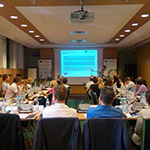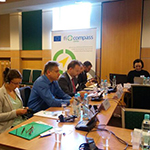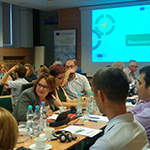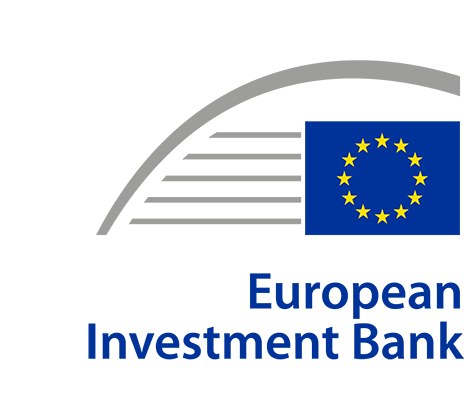Seminar 'EAFRD financial instruments in the 2014-2020 programming period'
Overview

Picture: Event overview
The seminar ‘EAFRD financial instruments in the 2014-2020 programming’, held on 24 May (afternoon) and 25 May 2018 (full day) at the premises of the Polish Ministry of Agriculture and Rural Development in Warsaw, focused on awareness raising, information sharing and training how financial instruments can help to deliver objectives of the European Agricultural Fund for Rural Development (EAFRD). At this event, representatives from the Ministry of Agriculture and Rural Development, the Ministry of Finance and the Agency for Restructuring and Modernisation of Agriculture (Paying Agency) in Poland learned about the regulatory requirements and practical aspects related to the deployment of EAFRD financial instruments in the 2014-2020 programming period.

Picture: Ms Szilvia Bencze, DG Agriculture and Rural Development, European Commission, Mr Nivelin Noev, DG Agriculture and Rural Development, European Commission, Mr Dariusz Nieć, Director for Rural Development, Ministry of Agriculture and Rural Development, Poland, Mr Robert Pernetta, European Investment Bank, Mr Mario Guido, European Investment Bank, Ms Anna Zurek, European Investment Bank
During his welcome address, Dariusz Nieć, Director for Rural Development, Ministry of Agriculture and Rural Development, Poland, underlined the seminar’s objectives and encouraged participants to use the occasion for training, information sharing and broadening of their knowledge about EAFRD financial instruments. Nivelin Noev, DG Agriculture and Rural Development (DG AGRI), European Commission, gave a short introduction about financial instruments under the EAFRD and presented an overview of the progress of implementation of financial instruments for agriculture and rural development in the different Member States and regions. During this presentation, participants had also the opportunity to familiarise themselves with the new opportunities provided by the new Omnibus regulation – Agricultural rules as well as the new legislative proposals for the Common Agricultural Policy (CAP) post-2020.
Rules, requirements and practical challenges when undertaking an ex-ante assessment for a financial instrument were described to participants by Anna Zurek, European Investment Bank (EIB). Subsequently, Robert Pernetta, EIB, shared with participants initial findings from the feasibility study under the EAFRD–EFSI Initiative for a financial instrument combining resources from the EAFRD and from the European Funds for Strategic Investments (EFSI) in Poland.
The second part of day 1 focused on EAFRD-supported loan instruments. Robert Pernetta described how such loan instruments work in practice and what their advantages are, especially from the perspective of final recipients. He also described in detail how loan instruments co-financed by the EAFRD are being deployed in practice in Romania and Estonia. This included also a presentation of the fi-compass case study video about loans for rural development 2014-2020 in Estonia.

Picture: Q&A and peer-to-peer discussion
At the seminar, participants could also deepen their knowledge and understanding about guarantee financial instruments supported by the EAFRD. During day 2 of the seminar, Mario Guido, EIB, talked about how such instruments work in practice. In the next session, participants could also hear insights from about concrete examples of guarantee instruments co-financed by the EAFRD: from Italy and Occitanie, France. Advantages of using EFSI resources in combination with EAFRD were highlighted by Robert Pernetta when presenting the EAFRD–EFSI Initiative to the audience.
Szilvia Bencze, DG AGRI, European Commission, illustrated in detail how financial instruments can be combined with other forms of support such as grants. In a separate presentation, she also described to the audience the different roles and responsibilities of the stakeholders involved in deployment of EAFRD financial instruments: EAFRD managing authorities, Paying Agencies, funds of funds and bodies implementing financial instruments. Anna Zurek briefly discussed the different implementation options available and main points to consider when selecting of bodies implementing financial instruments. A comprehensive Q&A and discussion session and closing remarks from the moderator concluded the seminar.
| Title | Speakers | ||
|---|---|---|---|
| |
Financial instruments for agriculture under the EAFRD in the 2014-2020 programming period – state of play and policy guidelines |
Nivelin Noev, DG AGRI, European Commission |
|
| |
fi-compass feasibility study for a financial instrument combining EAFRD and EFSI resources in Poland |
Robert Pernetta and Anna Zurek, European Investment Bank |
|
| |
Financial instruments structures: Loan instruments |
Robert Pernetta, European Investment Bank |
|
| |
Case studies: Loan instruments |
Robert Pernetta, European Investment Bank |
|
| |
Financial instruments structures: Guarantee instruments |
Mario Guido, European Investment Bank |
|
| |
EAFRD/EFSI initiative: advantages of using EFSI resources |
Robert Pernetta, European Investment Bank |
|
| |
Case studies: Guarantee Instruments |
Mario Guido, European Investment Bank |
|
| |
Implementing options and selection of the body implementing the financial instrument |
Anna Zurek, European Investment Bank |
|
| |
Combination of different forms of support - Role of different bodies in the implementation of financial instruments |
Szilvia Bencze, DG AGRI, European Commission |
|
| |
Final Discussion |

